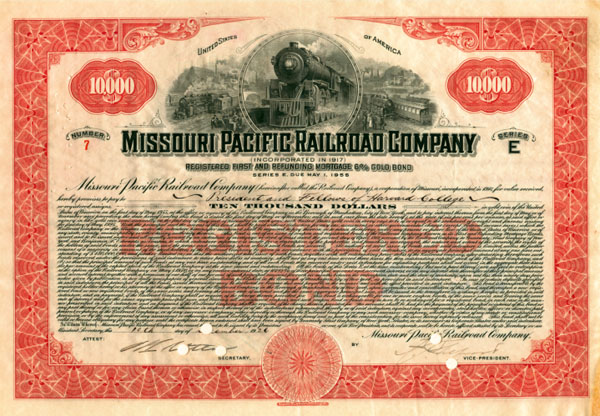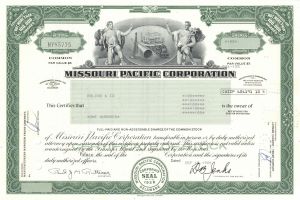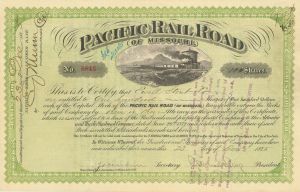Missouri Pacific Railroad - Bond
Inv# RB5612 Bond
$10,000 Bond. Republic Bank Note Co., Pittsburgh, PA. Low Bond #7. Neatly hole cancelled. Minor stain at right margin, otherwise nice. Very Rare!
The Missouri Pacific Railroad (reporting mark MP), commonly abbreviated as MoPac, was one of the first railroads in the United States west of the Mississippi River. MoPac was a Class I railroad growing from dozens of predecessors and mergers, including the St. Louis, Iron Mountain and Southern Railway (SLIMS), Texas and Pacific Railway (TP), Chicago and Eastern Illinois Railroad (C&EI), St. Louis, Brownsville and Mexico Railway (SLBM), Kansas, Oklahoma and Gulf Railway (KO&G), Midland Valley Railroad (MV), San Antonio, Uvalde and Gulf Railroad (SAU&G), Gulf Coast Lines (GC), International-Great Northern Railroad (IGN), Kansas, Nebraska & Dakota Railroad, New Orleans, Texas and Mexico Railway (NOTM), Missouri-Illinois Railroad (MI), as well as the small Central Branch Railway (an early predecessor of MP in Kansas and south central Nebraska), and joint ventures such as the Alton and Southern Railroad (AS).
In 1967, the railroad operated 9,041 miles of road and 13,318 miles of track, not including DK&S, NO&LC, T&P and its subsidiaries, C&EI and Missouri-Illinois.
Union Pacific Corporation, the parent company of the Union Pacific Railroad, agreed to buy the Missouri Pacific Railroad on January 8, 1980. Lawsuits filed by competing railroads delayed approval of the merger until September 13, 1982. After the Supreme Court denied a trial to the Southern Pacific, the merger took effect on December 22, 1982. However, due to outstanding bonds of the Missouri Pacific, its full merger into the Union Pacific Railroad did not become official until January 1, 1997.
On July 4, 1851, ground was broken at St. Louis on the Pacific Railroad, the predecessor of the Missouri Pacific Railroad. The first section of track was completed in 1852; in 1865, it was the first railroad in Kansas City, after construction was interrupted by the American Civil War. In 1872, the Pacific Railroad was reorganized as the Missouri Pacific Railway by new investors after a railroad debt crisis. Because of corporate ties extending back to the Pacific Railroad, Missouri Pacific at one time advertised itself as being "The First Railroad West of the Mississippi".
Missouri Pacific was under the control of New York financier Jay Gould from 1879 until his death in 1892. Gould developed a system extending through Colorado, Nebraska, Arkansas, Texas, and Louisiana. His son George Gould inherited control upon his father's death, but lost control of the company after it declared bankruptcy in 1915. The line was merged with the St. Louis, Iron Mountain and Southern Railway (SLIMS) and reorganized as the Missouri Pacific Railroad in 1917. Missouri Pacific later acquired or gained a controlling interest in other lines in Texas, including the Gulf Coast Lines, International-Great Northern Railroad, and the Texas and Pacific Railway.
MoPac declared bankruptcy again in 1933, during the Great Depression, and entered into trusteeship. The company was reorganized and the trusteeship ended in 1956.
By the 1980s the system would own 11,469 miles of rail line over 11 states bounded by Chicago to the east, Pueblo, Colorado, in the west, north to Omaha, south to the U.S.-Mexico border in Laredo, Texas, and southeast along the Gulf seaports of Louisiana and Texas. MoPac operated a fleet of more than 1,500 diesel locomotives, almost all purchased within the previous 10 years. Under the leadership of Downing B. Jenks, who became president and chief executive in 1961, the company became a pioneer in the early days of computer-guided rail technology. It was a major hauler of coal, grain, ore, autos, dry goods and shipping containers. At the time of its mega-merger in 1982, the MoPac owned more and newer locomotives and operated more track than partner Union Pacific Railroad.
On December 22, 1982 the Missouri Pacific was purchased by the Union Pacific Corporation and combined with the Western Pacific Railroad and Union Pacific Railroad to form one large railroad system. The new entity was called Pacific Rail Systems; though part of the Union Pacific Corporation, all three railroads maintained their own corporate and commercial identity. On December 1, 1989, the Missouri Kansas Texas and the Galveston, Houston & Henderson were merged into the Missouri Pacific after having been acquired by the Union Pacific Corporation in 1988.
By 1994 all motive power of the Missouri Pacific was repainted and on January 1, 1997, the Missouri Pacific was officially merged into the Union Pacific Railroad by the Union Pacific Corporation. UP continued to use the MoPac headquarters building at 210 N. 13th St. in downtown St. Louis for its customer service center until February 15, 2005. The former MoPac building has undergone rehab as apartments and is now known as Park Pacific.
By that same definition MP operated 10431 route-miles at the end of 1929, after A&G, SAS and Sugar Land had come under NOT&M; NO&LC operated 60 and DK&S (not subsidiary until 1931) operated 6. At the end of 1960 MP operated 9362 route-miles, NO&LC and DK&S were the same, and M-I operated 172 miles.
In the early years of the 20th century, most Missouri Pacific and St. Louis, Iron Mountain and Southern passenger trains were designated by number only, with little emphasis on premier name trains. This changed in May, 1915, with the inauguration of the Scenic Limited between St. Louis, Kansas City, and San Francisco. Between Pueblo, Colorado and Salt Lake City, the Scenic Limited operated through the Royal Gorge over the tracks of the Denver and Rio Grande Railroad. From Salt Lake City to San Francisco, the Scenic Limited operated over the Western Pacific Railroad. A second premier train, the Sunshine Special began operating on December 5, 1915, between St. Louis and San Antonio via Little Rock and Austin. Another named train, the Rainbow Special, was placed in service in July 1921 between Kansas City and Little Rock. The Sunshine Special soon eclipsed the other trains in travel volume, becoming the signature train of the Missouri Pacific Railroad. An advertising slogan in 1933 proclaimed: "It's 70-degrees in the Sunshine when it's 100-degrees in the shade," referring to the fact that the Sunshine Special was one of the first air-conditioned trains in the southwest. When new streamlined trains were delivered, the Scenic Limited and Rainbow Special names faded, but the Sunshine Special had sufficient name recognition to co-exist along with the new streamliners into the late 1950s.
In the streamliner era, the Missouri Pacific's premier passenger trains were collectively known as the Eagles. A variety of Eagle trains were operated, with the first such train inaugurated in 1940. These routes included the Missouri River Eagle (St. Louis-Kansas City-Omaha), the Delta Eagle (Memphis, Tennessee-Tallulah, Louisiana), the Colorado Eagle (St. Louis-Pueblo-Denver), the Texas Eagle (St. Louis to Texas), and the Valley Eagle (Houston-Corpus Christi-Brownsville, Texas).
Other notable MoPac trains operated included:
- the Houstonian (between New Orleans and Houston);
- Missourian (between St. Louis and Kansas City);
- Orleanean (between Houston and New Orleans);
- Ozarker (between St. Louis and Little Rock);
- Pioneer (between Houston and Brownsville);
- Southerner (service from Kansas City and St. Louis to New Orleans, via Little Rock);
- Southern Scenic (between Kansas City and Memphis);
- Sunflower (between St. Louis and Wichita); and
- the Texan (between St. Louis and Fort Worth).
Missouri Pacific gained a reputation for aggressively discontinuing passenger trains after the mid-1960s. When the National Railroad Passenger Corporation (Amtrak) assumed passenger train operations on May 1, 1971, the only Missouri Pacific route included as part of Amtrak's basic system was its main line from St. Louis to Kansas City. This route is now served by Amtrak's Missouri River Runner (named for the fact that it runs mostly parallel to the Missouri River). On March 13, 1974, Amtrak restored passenger train service over segments of Missouri Pacific-Texas and Pacific's original Texas Eagle route between St. Louis, Little Rock, Dallas, Austin, San Antonio, and Laredo with the Inter-American. This train was renamed the Texas Eagle in 1981, resurrecting the name of the famous MoPac train. The Amtrak version runs over former MoPac and T&P trackage for much of its route.
In the early days of steam, the MP generally used gold lettering on its steam locomotives. This was further broken down by using two different lettering styles: block for the numbers and roman for the lettering (including subsidiary markings and classifications). Once Lewis W. Baldwin became president of the Missouri Pacific in April 1923, the color of the lettering changed to aluminum.
The Missouri Pacific was known for its "Eagle" color scheme designed by Raymond Loewy. It consisted of dark cerulean, icterine yellow, and isabelline gray. These colors were mostly applied to passenger locomotives, passenger cars, merchandise boxcars and first-generation freight locomotives starting on October 22, 1939, and ending on April 27, 1961.
When the Texas & Pacific was acquired by the Missouri Pacific, the railroad discontinued its swamp holly orange and black for the Eagle colors (except icterine yellow) in its new order of GP18s 1145–1149 in May 1960; this follows the traditional practice of railroads using the parent company's colors.
Downing B. Jenks became president of the Missouri Pacific in 1961. To save money, Jenks introduced a new paint scheme for the railroad's locomotives. Starting April 28, 1961, all locomotives were to be painted in dark eagle blue with white accent marks but without the use of isabelline grey or icterine yellow. The name Jenks blue (also known as dark eagle blue) comes from Jenks' decision to change the livery of Missouri Pacific locomotives. EMD GP18 #400 made its debut in January 1962 with the simplified Jenks blue scheme. Starting in September 1974, when EMD GP38-2 #2111 was introduced, decals with the company's logo applied to locomotives used more reflective white surfaces for safety and visibility.
With the Union Pacific merger taking effect on December 22, 1982, the Missouri Pacific sought to keep its simple Jenks blue scheme. However, a study in late 1983 indicated the expense of all three railroads' paint schemes was too costly. Union Pacific then allowed the Missouri Pacific and Western Pacific railroads to create a new scheme that would represent all three railroads. Following the Missouri Pacific practice, the first paint scheme design consisted of an armor yellow carbody and a red frame sill with a black underframe, trucks and fuel tank. For added simplicity, this locomotive was to have the railroad's initials, logos and numbers applied. However, the scheme was discarded; instead a standard Union Pacific scheme with 20" lettering and 7/8" black edging, along with a 24" UP shield on the nose and a 10 1/2" UP shield on the air equipment doors, was used. Among the new features of this scheme were harbor mist gray trucks and anti-glare panels.
Once the test scheme was completed in January 1984, the lettering was deemed unsatisfactory due to the word Missouri being too large to fit on smaller four-axle carbodies. The Union Pacific scheme was to be used starting May 14, 1984, but instead of the Union Pacific "Jinx" typeface, a renovated version from the Missouri Pacific lettering was used. Using the typeface seen on Missouri Pacific reporting marks and locomotive numbers, block lettering (dubbed "North Little Rock lettering") was used, as it fit the large and small carbodies. The scheme was discontinued on January 1, 1986 after the consolidation of the Missouri Pacific & Union Pacific operating departments.
On July 30, 2005, UP unveiled a brand new EMD SD70ACe locomotive, Union Pacific 1982, with Missouri Pacific paint and logos, as part of a new heritage program.
A bond is a document of title for a loan. Bonds are issued, not only by businesses, but also by national, state or city governments, or other public bodies, or sometimes by individuals. Bonds are a loan to the company or other body. They are normally repayable within a stated period of time. Bonds earn interest at a fixed rate, which must usually be paid by the undertaking regardless of its financial results. A bondholder is a creditor of the undertaking.














Ebay ID: labarre_galleries